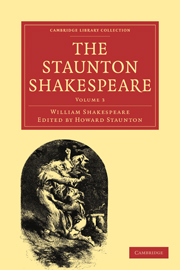MACBETH
Published online by Cambridge University Press: 29 August 2010
Summary
“The Tragedie of Macbeth” appears to have been first printed in the folio of 1623. The date of its composition is not determinable. Malone, from internal probabilities, satisfied himself that it must have been written not later than 1606: his chief grounds for this conviction being two passages in the Porter's soliloquy, Act II. Sc. 3:—“Here's a farmer that hanged himself on the expectation of plenty:” and, “Here's an equivocator, that could swear in both the scales against either scale; who committed treason enough for God's sake, yet could not equivocate to heaven.” In the former passage he detects an allusion to the extreme cheapness of corn in 1606, as shown by the audit book of Eton College; the latter he maintains, with great ingenuity, to be a pointed reference to the doctrine of equivocation avowed by Henry Garnet, superior of the order of Jesuits, on his trial for the Gunpowder Treason, in the same year. But there is, perhaps, still stronger evidence for conjecturing this tragedy was produced very early in the reign of James I., in the apparent allusion to the union of the three kingdoms under that monarch in 1604, in the words,—
“——Some I see
That two-fold balls and treble sceptres carry.”
- Type
- Chapter
- Information
- The Staunton Shakespeare , pp. 467 - 524Publisher: Cambridge University PressPrint publication year: 2009First published in: 1860



